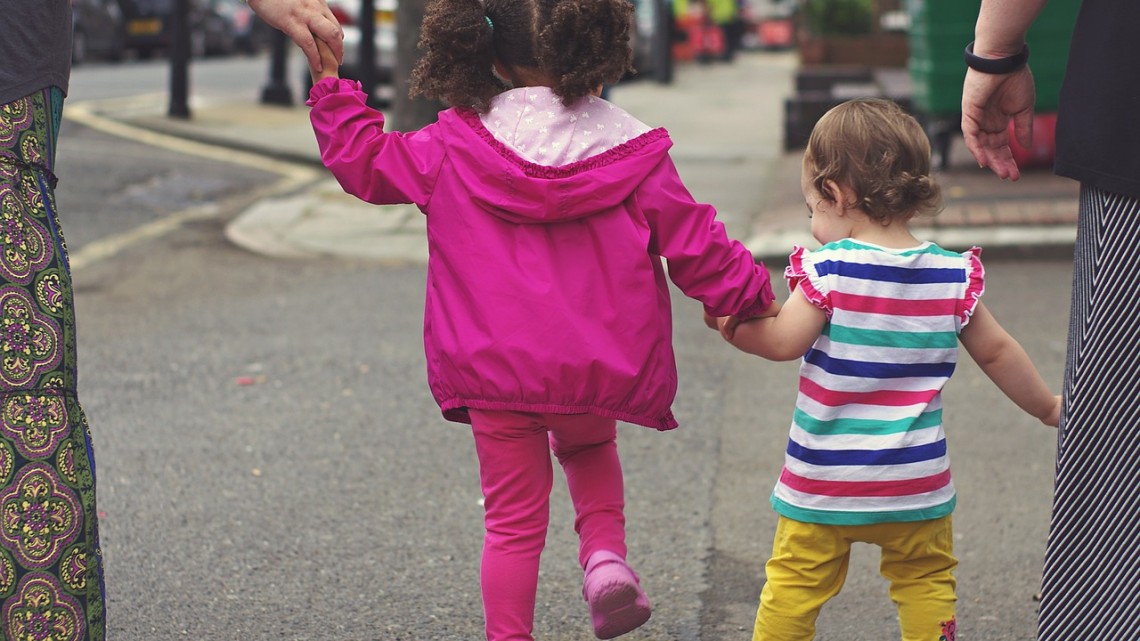It’s back-to-school season and everyone is excited! However, with anticipation is filling the air, many parents often dread the the following question, how safe is it for children walking to school?
There are some great benefits as well as major dangers for children walking to school that often worry many parents living in Pennsylvania. While it is a great way to promote exercise and a healthier lifestyle starting at such a young age, many accidents and child injuries often come from children walking to school. In 2014, the Pennsylvania Department of Transportation found that there were 591 child/pedestrian crashes involving a child ages 0-11. We often like to think that these injury number would decrease with age but we saw 512 reported child/pedestrian crashes involving children between 12-18; and this is just in Pennsylvania. The National Highway Traffic Safety Administration found that about 69,000 pedestrians are hurt each year, 11,000 of whom are younger than 14 years old.
These are startling numbers that often cause parents to shy away from allowing their kids to walk to school. However, if parents and children know about safety practices, our society could drastically decrease these risks. Therefore, we have asked seven experts scattered throughout Pennsylvania to weigh in on some of the most important questions associated children’s safety when walking to school.
Meet The Experts
- Alicia Dosheller handles the Allegheny County Health Department program: Traffic Safety Education Project in Pittsburgh
- Chelsea Pompeani is the Director of Public Affairs at AAA
- Delphine Torbik handles the personal health services sector of the Wilkes-Barre City Health Department for individuals and families in the community. She also collaborates with community representatives to promote general health and welfare of the city.
- Jeff Rosenbaum is a Philadelphia personal injury lawyer at Rosenbaum & Associates who handles cases involving injuries to children
- Juliann Sheldon is a Safety Press Officer at the Pennsylvania Department of Transportation (PennDOT)
- Kristen Urso is currently a Community Program Specialist with Children’s Hospital of Pittsburgh of UPMC, and the Program Coordinator for Safe Kids, Allegheny County
- Michael Spagnoletti is a Community Relations & Crime Prevention Officer for the Police Department where he educates children on programs such as seat belt safety, pedestrian safety, personal safety and injury prevention.
Here’s what they have to say about children walking to school
What is the biggest risk associated with children walking to school in Pennsylvania?
- Alicia Dosheller: There are numerous benefits associated with walking to school- it gives children exercise and allows them a sense of independence, and it cuts down on air pollution, congestion and bussing costs. The biggest risk associated with walking to school is pedestrian injury or death, however there are many precautions and practices that children can follow to stay safe while walking.
- Chelsea Pompeani: AAA’s number one priority is the safety of the general public. For children, the number one risk when walking to school is other drivers. 55 million children across the country will begin heading back to school. AAA urges motorists to slow down and stay alert in neighborhoods and school zones- before and after school hours. The afternoon hours are particularly dangerous for walking children between 3 pm & 7 pm.
-
Delphine Torbik: In my opinion there are two risks…the child being distracted and not aware of their surroundings while walking (cars and other people). Also not knowing how to appropriately cross the street –to look left, right and then left again before crossing. To use crosswalks and observe traffic lights.
-
Jeff Rosenbaum: Getting struck by a vehicle is typically the biggest risk associated with a young child walking to school, especially in high traffic areas
-
Juliann Sheldon: PennDOT believes that safety is the #1 priority for every individual on the roadways. That being said, pedestrians safety is at the forefront of our concern when it comes to children as pedestrians
-
Kristen Urso: According to Safe Kids Worldwide, every hour of every day- a teen pedestrian is killed or injured in the U.S. from being hit by a motor vehicle. Three hazards were identified as leading to this alarming trend: walking while distracted, walking in the dark, or crossing midblock/running across the street. “Distracted Walking” is injuring and killing pedestrians every day. In 2012, 488 children ages 19 and under died after being hit by a car while walking. Of those, 284 were teens ages 13-19. “Teens On the Move,” a 2014 research report from Safe Kids Worldwide with support from FedEx, was developed to understand why teens have the highest pedestrian rates among children 19 and under. In fact, the death rate for teens ages 13-19 is nearly three times that of children 5-12 years old, according to the study. More than 1,000 teens ages 13-18 were surveyed about their walking behaviors, and 40% said they had been hit or nearly hit by a car, bike, or motorcycle while walking.
- Michael Spagnoletti: Not paying attention to their safety due to distractions (Ipods, cell phone, friends, etc.) and horseplay. This includes personal as well as traffic safety.
What type if walking route in Pennsylvania would you deem safer for a child and why?
-
A route that follows a busy street (risk of pedestrian accident)
-
A route that followed secluded roads (risk of abduction)
- Alicia Dosheller: School districts often have designated walking routes that are considered safe for older children to utilize and it is recommended that students follow these routes. Generally, the safest routes to school will have a sidewalk or path that is separated from traffic with few or no street crossings (or if there is street crossing, cross where there is a school crossing guard).
- Delphine Torbik: Either route has their positive and negative points. As long as the child is aware of the route and safety tips
- Jeff Rosenbaum: The more traffic congestion the more a child is exposed to risk. Factors that increase risks include large intersections, lack of side walk, and blind spots in the roadway due to trees and turns. The risk will also be dramatically increased if the child is walking while it is dark or inclement weather. As much as possible try use smaller streets with less traffic. Also, if there is no sidewalk try to walk on the grass or other area next to the street
- Juliann Sheldon: There are a number of variables that should determine the safest walking route for a child/group of children. Are there pedestrian sidewalks along this route? Are there high visibility crosswalks so that pedestrians can safely cross the street? How about pedestrian channelizing devices? Every route will be different. Parents or local officials (police, school district officials, etc.) should determine which route is best depending on the particular child, local infrastructure, current safety practices in place (walk/don’t walk signals, crosswalks, visibility, etc.)
- Kristen Urso: Safe Kids Allegheny County agrees with Juliann’s (PennDOT) response
- Michael Spagnoletti: I would prefer the child to travel along busier streets provided there are safe lanes/sidewalks for them to walk. Not highways but also not secluded roadways.
At what age do you think a child can walk to school by themselves and why?
- Alicia Dosheller: While there is no federal or state law on what age is acceptable for walking to school, the National Highway Traffic Safety Administration suggests that children are generally not ready to walk to school without an adult until age 10. Every child is different and it takes time and practice for a child to develop the skills needed to be a safe pedestrian. Additionally, school districts may have their own policy on the subject.
- Delphine Torbik: I think it depends on the child-their maturity level and their confidence to walk alone. I think a 10 year old could walk alone but personally I would feel more comfortable at 12 years
- Jeff Rosenbaum: There is no set age for when a child should be allowed to walk to school by themselves. It is really dependent on child’s development and maturity level. Also the length and nature of the route would also affect when it is appropriate. Usually by the age of 10, however, many kids are permitted to walk alone
- Juliann Sheldon: Children mature at different ages. Also, not all children are properly educated in pedestrian safety. A child is prepared to walk to school by themselves when they have been properly educated in pedestrian safety and the rules of the road.
- Kristen Urso: The parent should determine this dependent on the walking route, and maturity of the child.
- Michael Spagnoletti: I say around age 13, but never alone always with others
What is the longest distance a child should be walking to school, both alone and with friends/siblings in Pennsylvania
- Alicia Dosheller: The maximum distance a student should be walking to school depends on the age of the child, the route, and the conditions. According to Safe Routes to School, most students are willing to walk up to a half hour to school (which is about a mile and a half
- Delphine Torbik: There is such a push these days for children to exercise so what a better way to get some exercise in than to walk to school. The number of children who walk to school has gone down over the years. The age of the child needs to be taken into consideration but in my opinion a reasonable amount would be no more than a mile
- Jeff Rosenbaum: Typically if children are walking to school the distance is 1 mile or less. If the child is younger than ½ mile is more appropriate depending on the particular child and the area
- Juliann Sheldon: Again, there are so many variables that a parent should take into consideration before allowing a child to walk alone. See my answer for question 3.
- Kristen Urso: [There are] too many variables to provide a standard recommendation”
- Michael Spagnoletti: I think anything over a few blocks is too long. It depends on the size of the blocks city versus rural but once you go above 5 blocks it should involve busing or driving.
As a driver in Pennsylvania, what are some safety practices you can apply with the new school year here?
- Alicia Dosheller: Drivers should abide by the school zone speed limits, yield to crossing guards, and be aware of pedestrians around them
- Chelsea Pompeani:
- Slow down. Speed limits in school zones are reduced for a reason.
- Eliminate distractions. Taking your eyes off the road for just two seconds doubles your chances of crashing.
- Come to a complete stop. Check carefully for children on sidewalks and don’t roll through a stop sign.
- Watch for bikes. Children on bicycles are often unpredictable. Expect the unexpected.
- Delphine Torbik: Very simply be alert to your surroundings, follow rules of the road and most importantly avoid distractions…phone, texting, loud music, talking, eating and drinking while driving
- Jeff Rosenbaum:
- Comply with local school drop-off and pick-up procedures for the safety of all children accessing the school.
- Avoid double parking or stopping on crosswalks to let children out of the car. Double parking will block visibility for other children and other motorists. Visibility is further reduced during the rain and fog seasons when condensation forms on car windows.
- Avoid loading or unloading children at locations across the street from the school. This forces youngsters to unnecessarily cross busy streets—often mid-block rather than at a crosswalk.
- Watch for children walking or bicycling (both on the road and the sidewalk) in areas near a school.
- Watch for children playing and gathering near bus stops. Watch for children arriving late for the bus, who may dart into the street without looking for traffic.
- Watch for children walking or biking to school when backing up (out of a driveway or leaving a garage).
- Juliann Sheldon: As the school year begins, we encourage motorists to exercise patience and drive distraction free. In addition, there are a few school-safety related laws to remind motorists of…
- Motorists approaching a school bus with its red lights flashing and stop arm extended are required to stop in all directions at least 10 feet from the bus. The only exception to the law is when a school bus is stopped on the opposite side of a highway clearly separated by a divider, such as concrete barriers or grass medians. Even in this situation, motorists should remain watchful of students trying to cross the road to catch the bus. If convicted of violating Pennsylvania’s school bus stopping law, drivers face a $250 fine, five points on their driving record and a 60-day license suspension.
- Students are also exposed to traffic while waiting for buses or walking to the bus stop or school. Motorists are reminded to be cautious and alert when approaching a school bus stop and to stop for pedestrians in crosswalks.
- In addition to watching for school buses, motorists should be alert in school zones, which become hubs of vehicle and pedestrian traffic. Motorists are required to slow down to the posted speed limit of 15 mph in school zones. If convicted, violators face a fine and three points on their driving record.
- Kristen Urso: Safe Kids Allegheny County agrees with Juliann (PennDOT) and Chelsea’s (AAA) response
- Michael Spagnoletti:
- Drivers need to eliminate/turn off the distractions (Radio, phone, eating, reading, etc.).
- Get completely ready before leaving for work and avoid finishing while driving. Focus on driving only.
- Slow down and constantly scan for children/hazards.
- Pay extra attention during school hours and avoid being late which leads to excessive speed and inattention by the driver.
As a parent living in Pennsylvania, what are some safety tips you can teach children walking to school this year?
- Alicia Dosheller: Before allowing a student to walk to school, parents should decide that their child has the skills to safely navigate traffic without them. Parents should also help choose the route to school, and walk with them prior to determine if there are any hazards. Children should be reminded to never accept a ride from a stranger or veer off the established route.
- Chelsea Pompeani:
- Look out for AAA School Safety Patrollers. AAA has more than 600,000 patrollers at nearly 31,000 schools across the country. They’re a sure sign you’re approaching the school zone and out of harm’s way.
- Stay alert. AAA released a study at the beginning of the summer noting that more people than ever on the roads are distracted behind the wheel of a car.
- It’s important to make sure students are keeping an eye on vehicles driving around them as well.
- Be sure to get them out the door in time.
- Delphine Torbik:
- Teach them how to safely cross the street…look left, right, and then left again.
- Observe traffic lights.
- Use crosswalks.
- Do not talk to strangers.
- Definitely never get into a strangers car.
- Know the route they are taking and tell the child not to take short cuts.
- Jeff Rosenbaum:
- Try to walk with a friend.
- Look out for cars pulling out of driveways and parking spots.
- Wear bright-colored clothes.
- If it is dark use a flashlight.
- Obey traffic signals.
- Do not run across the street.
- Only cross at intersections.
- Continue to look for traffic until you completely crossed the street
- Juliann Sheldon:
- Look both ways before crossing the street (look left, right, and then left again);
- Cross only within a clearly marked cross walk;
- Obey Walk/Don’t Walk traffic signals;
- Walk defensively: Don’t always assume a driver sees you. Even within a high visibility crosswalk, a driver may be distracted;
- Walk in groups whenever possible;
- Dress in brightly colored clothing
- Kristen Urso: All pedestrians need to be aware of their surroundings when walking, and put any electronic devices away to minimize distractions
- Michael Spagnoletti:
- Don’t speak, go near or go with anyone you don’t know or don’t have permission to do so with.
- Wear bright clothing.
- Travel on sidewalk or if no sidewalk on side facing traffic as far from roadway as possible. Leave early and tie shoes properly.
- Cross at safe crossings after looking both ways.
- Never assume a driver will stop, wait until they do to cross.
- Report suspicious activity, incidents and dangerous areas to your teacher and parent.
- Look out for others if you can do so safely.
Using these experts’ advice, the community can implement better safety practices for children walking to school as well as decrease the risk of child injury and pedestrian accidents in Pennsylvania and throughout the rest of the country. Do you have any additional advice? Tell us below!





No Comment